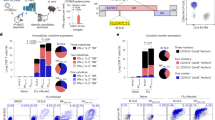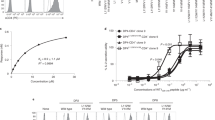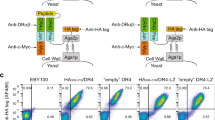Abstract
Immunodominance is defined as restricted responsiveness of T cells to a few selected epitopes from complex antigens. Strategies currently used for elucidating CD4+ T cell epitopes are inadequate. To understand the mechanism of epitope selection for helper T cells, we established a cell-free antigen processing system composed of defined proteins: human leukocyte antigen-DR1 (HLA-DR1), HLA-DM and cathepsins. Our reductionist system successfully identified the physiologically selected immunodominant epitopes of two model antigens: hemagglutinin-1 (HA1) from influenza virus (A/Texas/1/77) and type II collagen (CII). When applied for identification of new epitopes from a recombinant liver-stage antigen of malaria falciparum (LSA-NRC) or HA1 from H5N1 influenza virus ('avian flu'), the system selected single epitopes from each protein that were confirmed to be immunodominant by their capacity to activate CD4+ T cells from H5N1-immunized HLA-DR1–transgenic mice and LSA-NRC–vaccinated HLA-DR1–positive human volunteers. Thus, we provide a new tool for the identification of physiologically relevant helper T cell epitopes from antigens.
This is a preview of subscription content, access via your institution
Access options
Subscribe to this journal
Receive 12 print issues and online access
$259.00 per year
only $21.58 per issue
Buy this article
- Purchase on SpringerLink
- Instant access to full article PDF
Prices may be subject to local taxes which are calculated during checkout





Similar content being viewed by others
Accession codes
References
Sercarz, E.E. et al. Dominance and crypticity of T cell antigenic determinants. Annu. Rev. Immunol. 11, 729–766 (1993).
Sercarz, E.E. Immune focusing vs diversification and their connection to immune regulation. Immunol. Rev. 164, 5–10 (1998).
Lamb, J.R., Eckels, D.D., Lake, P., Woody, J.N. & Green, N. Human T-cell clones recognize chemically synthesized peptides of influenza haemagglutinin. Nature 300, 66–69 (1982).
Rosloniec, E.F. et al. An HLA-DR1 transgene confers susceptibility to collagen-induced arthritis elicited with human type II collagen. J. Exp. Med. 185, 1113–1122 (1997).
Jensen, P.E. Recent advances in antigen processing and presentation. Nat. Immunol. 8, 1041–1048 (2007).
Amigorena, S., Drake, J.R., Webster, P. & Mellman, I. Transient accumulation of new class II MHC molecules in a novel endocytic compartment in B lymphocytes. Nature 369, 113–120 (1994).
Kropshofer, H. et al. Editing of the HLA-DR-peptide repertoire by HLA-DM. EMBO J. 15, 6144–6154 (1996).
Chou, C.L. & Sadegh-Nasseri, S. HLA-DM recognizes the flexible conformation of major histocompatibility complex class II. J. Exp. Med. 192, 1697–1706 (2000).
Riberdy, J.M., Newcomb, J.R., Surman, M.J., Barbosa, J.A. & Cresswell, P. HLA-DR molecules from an antigen-processing mutant cell line are associated with invariant chain peptides. Nature 360, 474–477 (1992).
Sloan, V.S. et al. Mediation by HLA-DM of dissociation of peptides from HLA-DR. Nature 375, 802–806 (1995).
Sadegh-Nasseri, S., Chen, M., Narayan, K. & Bouvier, M. The convergent roles of tapasin and HLA-DM in antigen presentation. Trends Immunol. 29, 141–147 (2008).
Plüger, E.B. et al. Specific role for cathepsin S in the generation of antigenic peptides in vivo. Eur. J. Immunol. 32, 467–476 (2002).
Riese, R.J. et al. Essential role for cathepsin S in MHC class II–associated invariant chain processing and peptide loading. Immunity 4, 357–366 (1996).
Chapman, H.A. Endosomal proteases in antigen presentation. Curr. Opin. Immunol. 18, 78–84 (2006).
Pisoni, R.L., Acker, T.L., Lisowski, K.M., Lemons, R.M. & Thoene, J.G. A cysteine-specific lysosomal transport system provides a major route for the delivery of thiol to human fibroblast lysosomes: possible role in supporting lysosomal proteolysis. J. Cell Biol. 110, 327–335 (1990).
Maric, M. et al. Defective antigen processing in GILT-free mice. Science 294, 1361–1365 (2001).
Boja, E.S. & Fales, H.M. Overalkylation of a protein digest with iodoacetamide. Anal. Chem. 73, 3576–3582 (2001).
Schey, K.L. & Finley, E.L. Identification of peptide oxidation by tandem mass spectrometry. Acc. Chem. Res. 33, 299–306 (2000).
Narayan, K. et al. Staphylococcal enterotoxin A induces small clusters of HLA-DR1 on B cells. PLoS ONE 4, e6188 (2009).
Van den Steen, P.E. et al. Cleavage of denatured natural collagen type II by neutrophil gelatinase B reveals enzyme specificity, post-translational modifications in the substrate and the formation of remnant epitopes in rheumatoid arthritis. FASEB J. 16, 379–389 (2002).
Van den Steen, P.E. et al. Generation of glycosylated remnant epitopes from human collagen type II by gelatinase B. Biochemistry 43, 10809–10816 (2004).
Stern, L.J. & Wiley, D.C. The human class II MHC protein HLA-DR1 assembles as empty αβ heterodimers in the absence of antigenic peptide. Cell 68, 465–477 (1992).
Krzych, U. et al. T lymphocytes from volunteers immunized with irradiated Plasmodium falciparum sporozoites recognize liver and blood stage malaria antigens. J. Immunol. 155, 4072–4077 (1995).
Fidock, D.A. et al. Plasmodium falciparum liver stage antigen-1 is well conserved and contains potent B and T cell determinants. J. Immunol. 153, 190–204 (1994).
Hillier, C.J. et al. Process development and analysis of liver-stage antigen 1, a preerythrocyte-stage protein-based vaccine for Plasmodium falciparum. Infect. Immun. 73, 2109–2115 (2005).
Cummings, J.F. et al. Recombinant liver stage antigen-1 (LSA-1) formulated with AS01 or AS02 is safe, elicits high titer antibody and induces IFN-γ/IL-2 CD4+ T cells but does not protect against experimental Plasmodium falciparum infection. Vaccine 28, 5135–5144 (2010).
Deussing, J. et al. Cathepsins B and D are dispensable for major histocompatibility complex class II–mediated antigen presentation. Proc. Natl. Acad. Sci. USA 95, 4516–4521 (1998).
Parker, C.E., Papac, D.I., Trojak, S.K. & Tomer, K.B. Epitope mapping by mass spectrometry: determination of an epitope on HIV-1 IIIB p26 recognized by a monoclonal antibody. J. Immunol. 157, 198–206 (1996).
Chicz, R.M. et al. Predominant naturally processed peptides bound to HLA-DR1 are derived from MHC-related molecules and are heterogeneous in size. Nature 358, 764–768 (1992).
Hunt, D.F. et al. Characterization of peptides bound to the class I MHC molecule HLA-A2.1 by mass spectrometry. Science 255, 1261–1263 (1992).
Strug, I. et al. Vaccinia peptides eluted from HLA-DR1 isolated from virus-infected cells are recognized by CD4+ T cells from a vaccinated donor. J. Proteome Res. 7, 2703–2711 (2008).
Ireland, J., Herzog, J. & Unanue, E.R. Cutting edge: unique T cells that recognize citrullinated peptides are a feature of protein immunization. J. Immunol. 177, 1421–1425 (2006).
Beltrami, A. et al. Citrullination-dependent differential presentation of a self-peptide by HLA-B27 subtypes. J. Biol. Chem. 283, 27189–27199 (2008).
Gebe, J.A. & Kwok, W.W. Tracking antigen specific CD4+ T-cells with soluble MHC molecules. Methods Mol. Med. 136, 39–50 (2007).
Narayan, K. et al. HLA-DM targets the hydrogen bond between the histidine at position β81 and peptide to dissociate HLA-DR–peptide complexes. Nat. Immunol. 8, 92–100 (2007).
Suri, A. et al. In APCs, the autologous peptides selected by the diabetogenic I-Ag7 molecule are unique and determined by the amino acid changes in the P9 pocket. J. Immunol. 168, 1235–1243 (2002).
Natarajan, S.K., Stern, L.J. & Sadegh-Nasseri, S. Sodium dodecyl sulfate stability of HLA-DR1 complexes correlates with burial of hydrophobic residues in pocket 1. J. Immunol. 162, 3463–3470 (1999).
Acknowledgements
We wish to thank S. Landry, A. Hamad, J. Pomerantz and K. Narayan for reading the manuscript and insightful discussions, S. Khoruzhenko for protein production, S. Kalb-Ramirez and D. Wang for the initial mass spectrometry, F. Korangy and D. Pardoll (Johns Hopkins University) for Escherichia coli transformed with an expression vector encoding influenza HA, D. Zaller (Merck) for the original DR1-transgenic mice, L. Rein for testing the human samples and the US National Institutes of Health Tetramer Facility for providing DR1 and CLIP monomers. This work was supported by R01 grants AI063764 and GM053549, a grant from Johns Hopkins Malaria Research Institute to S.S.-N., a US National Science Foundation predoctoral award to I.Z.H. and a Johns Hopkins University Rheumatology T32 Fellowship to A.K.
Author information
Authors and Affiliations
Contributions
I.Z.H. and A.K. designed and executed experiments, analyzed data and wrote the paper; R.J.C., W.G., T.B. and R.N.C. provided mass spectrometry data and analyses; K.W. cloned DM; S.K.D. contributed to in vivo testing; R.S., D.E.L. and U.K. did LSA-1 experiments in humans; and S.S.-N. designed experiments, supervised the project, obtained funding and wrote the paper.
Corresponding author
Ethics declarations
Competing interests
The authors declare no competing financial interests.
Supplementary information
Supplementary Text and Figures
Supplementary Figures 1–14 and Supplementary Tables 1–4 (PDF 773 kb)
Rights and permissions
About this article
Cite this article
Hartman, I., Kim, A., Cotter, R. et al. A reductionist cell-free major histocompatibility complex class II antigen processing system identifies immunodominant epitopes. Nat Med 16, 1333–1340 (2010). https://doi.org/10.1038/nm.2248
Received:
Accepted:
Published:
Issue date:
DOI: https://doi.org/10.1038/nm.2248
This article is cited by
-
CD4+ Th immunogenicity of the Ascaris spp. secreted products
npj Vaccines (2020)
-
What to do with HLA-DO/H-2O two decades later?
Immunogenetics (2019)
-
Distorted Immunodominance by Linker Sequences or other Epitopes from a Second Protein Antigen During Antigen-Processing
Scientific Reports (2017)
-
Creation of an engineered APC system to explore and optimize the presentation of immunodominant peptides of major allergens
Scientific Reports (2016)
-
Divergent paths for the selection of immunodominant epitopes from distinct antigenic sources
Nature Communications (2014)



